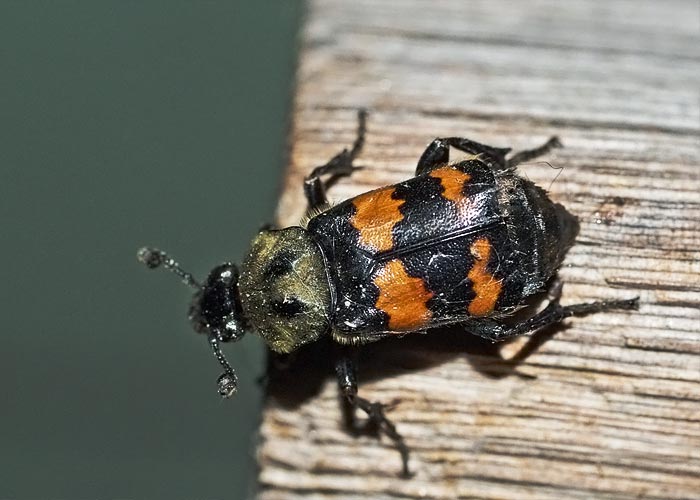Howdy, BugFans,
The BugLady was faced with an entomological conundrum recently. One the one hand, the beetle in front of her was marked similarly to a burying beetle (of previous BOTW fame). On the other hand, it was longer and slimmer than your average burying beetle and, more importantly, it could easily outrun the BugLady, who can generally move faster than a burying beetle. A little research on bugguide.net revealed it to be a Hairy Rove Beetle (HRB), a beetle whose habitat smells roughly the same as a Burying beetle’s habitat. Although the two may hang out in or under the same corpses, the burying beetle attends to the dead, while a rove beetle’s business is (mainly) with the living.
Hairy Rove Beetle
Hairy Rove Beetles are in the rove beetle family Staphylinidae, a family that has graced the earth for upwards of 200 million years. Rove beetles haven’t wasted those 200,000,000 years—they comprise the second largest beetle family (after the weevil family) with 46,000+ species (a hotly-contested number). There are just under 3,000 species in North America. With 400 new species being described and classified annually, some suggest that there are a bundle of yet-to-be-discovered rove beetles, mostly tropical.
[metaslider id=5815]
References describe their mouthparts with phrases like “stout mandibles” and “needle-like” and their bite as “painful.” Their antennae lack the clubs that adorn the ends of a burying beetle’s antennae. Where most beetles’ elytra (the hard wing covers that protect their membranous flying wings) are about the same length as their abdomens, rove beetles have dramatically-shortened elytra (burying beetles’ elytra are somewhat-shortened). Most rove beetles have standard flying wings that are simply tucked up into a smaller space. The HRB (Creophilus maxillosus) maxes out at around an inch, but most rove beetles are much smaller. Their short elytra allow them a lot of flexibility, and they sometimes run around with abdomens raised, resembling earwigs.
HRBs, aka Gray and black rove beetles, can be found during temperate months in woods east of the Mississippi and also across The Pond. There they mostly hide out under stuff—dead bark, rocks, leaf litter, dung and carrion. Most rove beetles are carnivores or scavengers as both adults and larvae, but a few species eat mushrooms and plant materials. HRBs eat carrion and also (as one source puts it) the “nutrient-packed” maggots and other larvae that inhabit carcasses.
They come equipped with defenses at both ends. HRBs produce a cocktail of chemicals, most with names longer than the HRB itself, that is dispensed in a fine mist both irritates and offends. The chemicals are known repellants of ants, which are common rove beetle enemies (though some rove beetles have symbiotic relationships with ants and even live in ant hills).
HRBs in the News:
- Because it hangs out around dead bodies, the HRB is counted among the insect tools of Forensic Entomologists who determine post-mortem intervals. It must be figured into the equation because it decreases the maggot count.
- HRBs have been studied with an eye to reducing fly infestations in cattle feedlots.
Devil’s Coach Horse Beetle
The Devil’s Coach Horse, a rove beetle that’s even larger than the HRB, is a European species that has made its way to parts of California. The Devil’s Coach Horse is, allegedly, the Devil’s “familiar”—the disguise used by the Devil when he comes to eat sinners. When it raises its abdomen, it is said to be casting a curse (or something really smelly). Google “devil’s coach horse beetle” for a picture of this impressive critter. The Wikipedia entry shows one attacking an earthworm about a gazillion times larger than it is.
The burying beetle pictured here for comparison was walking around in the BugLady’s basement recently. While she is not surprised that there are Dead Things down there, she doesn’t want to believe that there are Dead Things buried down there—the cardboard box collection?), so she caught and released it. The burying beetle has world-class halitosis; you are what you eat.
The Bug Lady
